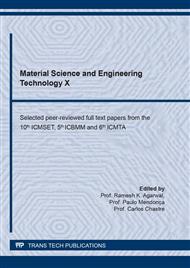[1]
T. Asano y B. Jimenez, Water Reuse An International Survey of current practice, issues and needs, núm. 20. Londres, (2008).
Google Scholar
[2]
P. Ricardo et al., Use of recycled water from mixer truck wash in concrete : Effect on the hydration , fresh and hardened properties,, Constr. Build. Mater., vol. 230, p.116981, 2020,.
DOI: 10.1016/j.conbuildmat.2019.116981
Google Scholar
[3]
S. Vajnhandl y J. V. Valh, The status of water reuse in European textile sector,, J. Environ. Manage., vol. 141, p.29–35, 2014,.
DOI: 10.1016/j.jenvman.2014.03.014
Google Scholar
[4]
A. V. Hernández, D. Alejandro, y R. Cardona, Sustainability ,: núm. 1, p.105–118, (2012).
Google Scholar
[5]
M. Shekarchizadeh, M. Yazdian, y N. Mehrdadi, Use of biologically treated domestic waste water in concrete,, Kuwait J. Sci. Eng., vol. 39, núm. 2 B, p.97–111, (2012).
Google Scholar
[6]
T.R. Naik, Sustainability of the cement and concrete industries,, Sustain. Constr. Mater. Technol. - Int. Conf. Sustain. Constr. Mater. Technol., p.19–25, (2007).
Google Scholar
[7]
Çevre ve Şehircilik Bakanlği, Treatment and reuse of wastewater",, Man. para Munic. ecoeficientes, vol. 2, núm. 511, p.179, 2009, [En línea]. Disponible en: https://sinia.minam.gob.pe/download/file/fid/39054.
Google Scholar
[8]
G. Asadollahfardi, M. Delnavaz, V. Rashnoiee, y N. Ghonabadi, Use of treated domestic wastewater before chlorination to produce and cure concrete,, Constr. Build. Mater., vol. 105, p.253–261, 2016,.
DOI: 10.1016/j.conbuildmat.2015.12.039
Google Scholar
[9]
F. S. Peighambarzadeh, G. Asadollahfardi, y J. Akbardoost, The effects of using treated wastewater on the fracture toughness of the concrete,, Aust. J. Civ. Eng., vol. 00, núm. 00, p.1–9, 2020,.
DOI: 10.1080/14488353.2020.1712933
Google Scholar
[10]
K. Meena y S. Luhar, Author' s Accepted Manuscript Effect of wastewater on properties of Concrete,, J. Build. Eng., 2018,.
Google Scholar
[11]
A. M. Ghrair y O. Al-Mashaqbeh, Domestic wastewater reuse in concrete using bench-scale testing and full-scale implementation,, Water (Switzerland), vol. 8, núm. 9, 2016,.
DOI: 10.3390/w8090366
Google Scholar
[12]
B. Yahyaei, Workability, mechanical, and durability properties of self-compacting concrete using the treated wastewater,, núm. December 2019, p.1–12, 2020,.
DOI: 10.1002/suco.201900447
Google Scholar
[13]
P. Rama Mohan Rao, S. M. K. Moinuddin, y P. Jagadeesh, Effect of treated waste water on the properties of hardened concrete,, Int. J. Chem. Sci., vol. 12, núm. 1, p.155–162, 2014,.
Google Scholar
[14]
ASTM C150-21, Standard Specification for Portland Cement.
Google Scholar
[15]
ASTM C33-18, Standard Specification for Concrete Aggregates.
Google Scholar
[16]
ASTM C494-19, Standard Specification for Chemical Admixtures for Concrete.
Google Scholar
[17]
ASTM C94/C94M-14b. Standard specification for ready mix concrete; (1994).
Google Scholar
[18]
American Concrete Institute Mix Design of Concrete, ACI 211.1, (2007).
Google Scholar
[19]
ASTM C192-19, Standard Practice for Making and Curing Concrete Test Specimens in the Laboratory.
Google Scholar
[20]
ASTM-C143, Standard Test Method for Slump of Hydraulic-Cement Concret.
Google Scholar
[21]
ASTM C191-19, Methods for Time of Setting of Hydraulic Cement by Vicat Needle.
Google Scholar
[22]
ASTM C39M-18, Method for Compressive Strength Cylindrical Concrete Specimen.
Google Scholar
[23]
ASTM C496M-17, Method for Splitting Tensile Strength of Cylindrical Concrete Specimens.
Google Scholar
[24]
ASTM C78M - 21, Standard Test Method for Flexural Strength of Concrete.
Google Scholar
[25]
Asadollahfardi, G., Delnavaz, M., Rashnoiee, V., & Ghonabadi, N. (2016). Use of treated domestic wastewater before chlorination to produce and cure concrete. Construction and Building Materials, 105, 253-261. https://doi.org/10.1016/j.conbuildmat.2015.12.039.
DOI: 10.1016/j.conbuildmat.2015.12.039
Google Scholar
[26]
Al-Joulani, N. M. A. (2019). Effect of using tertiary treated wastewater from nablus wastewater treatment plant (NWWTP), on some properties of concrete. International Journal of Innovative Technology and Exploring Engineering, 8(11), 2460-2466. https://doi.org/10.35940/ijitee. K1709.0981119.
DOI: 10.35940/ijitee.k1709.0981119
Google Scholar
[27]
Fahimeh Sadat Peighambarzadeh, Gholamreza Asadollahfardi & Javad Akbardoost (2020): The effects of using treated wastewater on the fracture toughness of the concrete, Australian Journal of Civil Engineering, https://doi.org/10.1080/14488353.2020.1712933.
DOI: 10.1080/14488353.2020.1712933
Google Scholar
[28]
Ghrair, A. M., Al-Mashaqbeh, O. A., Sarireh, M. K., Al-Kouz, N., Farfoura, M., & Megdal, S. B. (2018). Influence of grey water on physical and mechanical properties of mortar and concrete mixes. Ain Shams Engineering Journal, 9(4), 1519-1525. https://doi.org/10.1016/j.asej. 2016.11.005.
DOI: 10.1016/j.asej.2016.11.005
Google Scholar
[29]
O.O.I.S. Lee, M.R. Salim, M. Ismail, I. Ali, Reusing treated effluent in concrete Technology, J. Teknol. 34 (2007) 1–9. https://doi.org/10.11113/jt.v34.648.
Google Scholar
[30]
N. Mehrdadi, A. Akbarian, A. Haghollahi, Using domestic treated wastewater for producing and curing concrete, J. Environ. Stud. 35 (50) (2009) 129–136 (in Farsi).
Google Scholar
[31]
Farid, H., Mansoor, M. S., Shah, S. A. R., Khan, N. M., Shabbir, R. M. F., Adnan, M., … Waseem, M. (2019). Impact analysis of water quality on the development of construction materials. Processes, 7(9), 1-13. https://doi.org/10.3390/pr7090579.
DOI: 10.3390/pr7090579
Google Scholar
[32]
Mahasneh, B. Z. (2014). Assessment of replacing wastewater and treated water with tap water in making concrete mix. Electronic Journal of Geotechnical Engineering, 19 K(April), 2379-2386. https://doi.org/10.13140/2.1.3211.2323.
Google Scholar
[33]
R.V. Venkateswara, N. V. Ramana, K. Gnaneswar, C. Sashidhar, Effect of magnesium chloride (MgCl2) on ordinary Portland cement concrete. Indian J. Sci. Technol., 2011. 10.17485 / ijst / 2011 / v4i6.2.
DOI: 10.17485/ijst/2011/v4i6.2
Google Scholar
[34]
Meena, K., & Luhar, S. (2019). Effect of wastewater on properties of concrete. Journal of Building Engineering, 21, 106-112. https://doi.org/10.1016/j.jobe.2018.10.003.
DOI: 10.1016/j.jobe.2018.10.003
Google Scholar
[35]
Rama Mohan Rao, P., Moinuddin, S. M. K., & Jagadeesh, P. (2014). Effect of treated waste water on the properties of hardened concrete. International Journal of Chemical Sciences, 12(1), 155-162. https://doi.org/10.9790/1684-1306024145.
Google Scholar
[36]
Varshney, H., Khan, R. A., & Khan, I. K. (2021). Sustainable use of different wastewater in concrete construction: A review. Journal of Building Engineering, 41. https://doi.org/10.1016/ j.jobe.2021.102411.
DOI: 10.1016/j.jobe.2021.102411
Google Scholar


